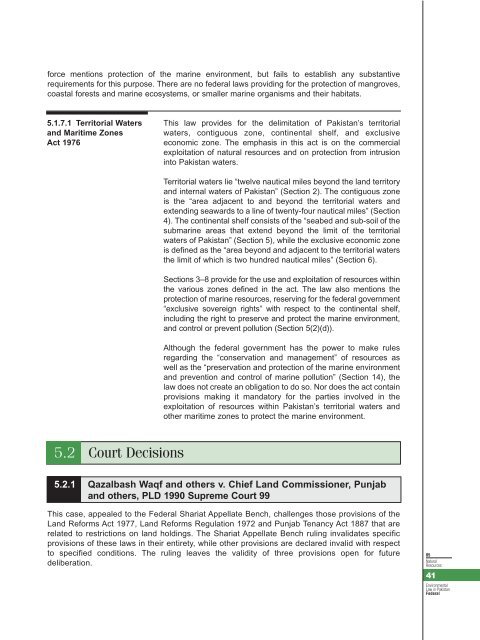“Apportionment of the Waters of the Indus River System Between theProv<strong>in</strong>ces” agreement. The ord<strong>in</strong>ance conta<strong>in</strong>s no provisions for theprotection of the Indus or the ecosystems supported by the river andits tributaries. The federal government has the power to make rules(Section 21), while the Authority may frame regulations (Section 22).5.1.6.4 Forest Act 1927Although this law focuses on forest-related issues, poison<strong>in</strong>g water<strong>in</strong> a reserved forest is an offence under Section 26(1)(i),punishable with a f<strong>in</strong>e of 500 rupees and/or a sentence of sixmonths <strong>in</strong> prison. This provision is difficult to enforce, however,s<strong>in</strong>ce the term “poison” has not been def<strong>in</strong>ed.5.1.6.5 Canal andDra<strong>in</strong>age Act 1873This act regulates irrigation, navigation and dra<strong>in</strong>age. All powersunder this act, <strong>in</strong>clud<strong>in</strong>g the power to make rules, have beendelegated to the prov<strong>in</strong>ces. Prov<strong>in</strong>cial governments may order anyriver, stream, lake, or water body to be used for any public purposeat any time (Section 5). The law conta<strong>in</strong>s no provisions for thesusta<strong>in</strong>able use of freshwater resources or for their preservation.5.1.6.6 <strong>Pakistan</strong> PenalCode 1860The <strong>Pakistan</strong> Penal Code (PPC) 1860 deals specifically with thepollution of water <strong>in</strong> Chapter XIV on public health and safety. Here,“foul<strong>in</strong>g” or “corrupt<strong>in</strong>g” the water of a public spr<strong>in</strong>g or reservoir islisted as an offence, punishable with up to three months <strong>in</strong> prisonand/or a f<strong>in</strong>e of 500 rupees (Section 277). This provision is limited<strong>in</strong> scope, s<strong>in</strong>ce it applies only to reservoirs and public spr<strong>in</strong>gs, andthe terms “foul<strong>in</strong>g” and “corrupt<strong>in</strong>g” are not def<strong>in</strong>ed. But provisionsof PEPA 1997 (Sections 6 and 7) and the NEQS (Appendix I) maybe applied to facilitate enforcement of Section 277. Other sectionsof this chapter may be <strong>in</strong>terpreted to <strong>in</strong>clude the protection of waterresources, <strong>in</strong>clud<strong>in</strong>g Section 268 on public nuisance, Section 269on negligence likely to spread <strong>in</strong>fectious disease, and Section 284on negligent conduct with respect to the possession and handl<strong>in</strong>gof poisonous substances.Similarly, Chapter XVII on offences aga<strong>in</strong>st property conta<strong>in</strong>scerta<strong>in</strong> provisions that may be <strong>in</strong>terpreted to <strong>in</strong>clude the protectionof water resources. Sections 425–440 deal with “mischief”, def<strong>in</strong>edas damage to property result<strong>in</strong>g <strong>in</strong> destruction or loss of utility.Section 430 provides specifically for mischief caused to irrigationworks, while Section 431 deals with damage to roads, bridges,rivers or channels. Meanwhile, Chapter XXIII, Section 511 onattempted offences could also be <strong>in</strong>terpreted to <strong>in</strong>clude offencesrelated to the “foul<strong>in</strong>g” or “corrupt<strong>in</strong>g” of water.05NaturalResources40<strong>Environmental</strong><strong>Law</strong> <strong>in</strong> <strong>Pakistan</strong>Federal5.1.7 Coastal and Mar<strong>in</strong>eThe subject of “environmental pollution and ecology”, which appears on the Concurrent LegislativeList (item 24), would <strong>in</strong>clude mar<strong>in</strong>e ecosystems. There are no federal laws that specifically controlcoastal areas. <strong>Law</strong>s regulat<strong>in</strong>g the mar<strong>in</strong>e environment are primarily concerned with facilitat<strong>in</strong>gmar<strong>in</strong>e fisheries and with transport by sea, and were enacted 30 to 165 years ago. Only one law <strong>in</strong>
force mentions protection of the mar<strong>in</strong>e environment, but fails to establish any substantiverequirements for this purpose. There are no federal laws provid<strong>in</strong>g for the protection of mangroves,coastal forests and mar<strong>in</strong>e ecosystems, or smaller mar<strong>in</strong>e organisms and their habitats.5.1.7.1 Territorial Watersand Maritime ZonesAct 1976This law provides for the delimitation of <strong>Pakistan</strong>’s territorialwaters, contiguous zone, cont<strong>in</strong>ental shelf, and exclusiveeconomic zone. The emphasis <strong>in</strong> this act is on the commercialexploitation of natural resources and on protection from <strong>in</strong>trusion<strong>in</strong>to <strong>Pakistan</strong> waters.Territorial waters lie “twelve nautical miles beyond the land territoryand <strong>in</strong>ternal waters of <strong>Pakistan</strong>” (Section 2). The contiguous zoneis the “area adjacent to and beyond the territorial waters andextend<strong>in</strong>g seawards to a l<strong>in</strong>e of twenty-four nautical miles” (Section4). The cont<strong>in</strong>ental shelf consists of the “seabed and sub-soil of thesubmar<strong>in</strong>e areas that extend beyond the limit of the territorialwaters of <strong>Pakistan</strong>” (Section 5), while the exclusive economic zoneis def<strong>in</strong>ed as the “area beyond and adjacent to the territorial watersthe limit of which is two hundred nautical miles” (Section 6).Sections 3–8 provide for the use and exploitation of resources with<strong>in</strong>the various zones def<strong>in</strong>ed <strong>in</strong> the act. The law also mentions theprotection of mar<strong>in</strong>e resources, reserv<strong>in</strong>g for the federal government“exclusive sovereign rights” with respect to the cont<strong>in</strong>ental shelf,<strong>in</strong>clud<strong>in</strong>g the right to preserve and protect the mar<strong>in</strong>e environment,and control or prevent pollution (Section 5(2)(d)).Although the federal government has the power to make rulesregard<strong>in</strong>g the “conservation and management” of resources aswell as the “preservation and protection of the mar<strong>in</strong>e environmentand prevention and control of mar<strong>in</strong>e pollution” (Section 14), thelaw does not create an obligation to do so. Nor does the act conta<strong>in</strong>provisions mak<strong>in</strong>g it mandatory for the parties <strong>in</strong>volved <strong>in</strong> theexploitation of resources with<strong>in</strong> <strong>Pakistan</strong>’s territorial waters andother maritime zones to protect the mar<strong>in</strong>e environment.5.2 Court Decisions5.2.1 Qazalbash Waqf and others v. Chief Land Commissioner, Punjaband others, PLD 1990 Supreme Court 99This case, appealed to the Federal Shariat Appellate Bench, challenges those provisions of theLand Reforms Act 1977, Land Reforms Regulation 1972 and Punjab Tenancy Act 1887 that arerelated to restrictions on land hold<strong>in</strong>gs. The Shariat Appellate Bench rul<strong>in</strong>g <strong>in</strong>validates specificprovisions of these laws <strong>in</strong> their entirety, while other provisions are declared <strong>in</strong>valid with respectto specified conditions. The rul<strong>in</strong>g leaves the validity of three provisions open for futuredeliberation.05NaturalResources41<strong>Environmental</strong><strong>Law</strong> <strong>in</strong> <strong>Pakistan</strong>Federal
















